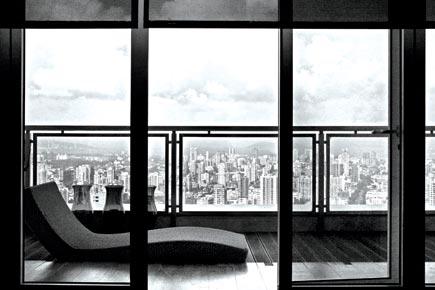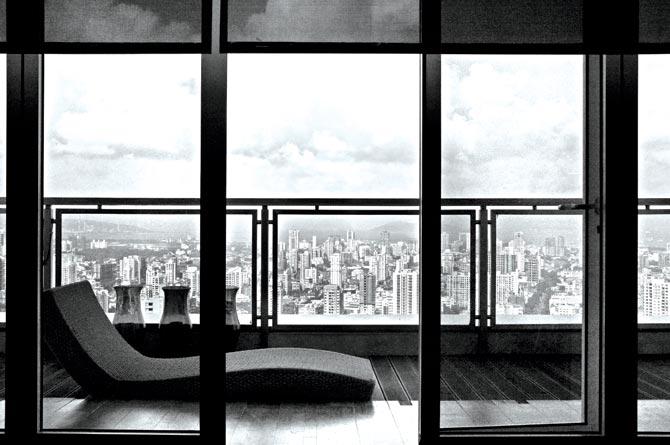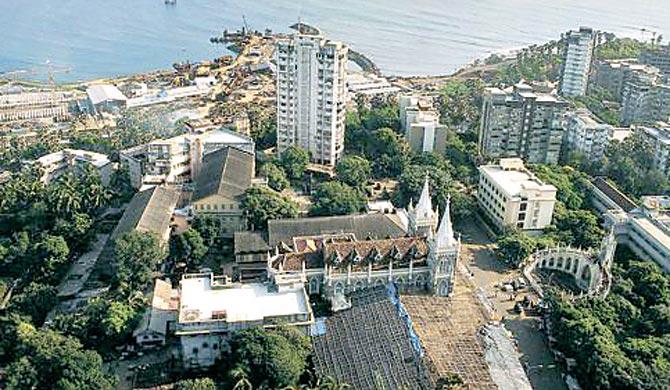Kite fliers readying for Makar Sankranti treat themselves to aerial views of the city also engagingly shot by photographers


A panoramic view of the skyline stretching below a Tardeo tower, taken from its 36th floor. Pic/Chirodeep Chaudhuri
 The heady rush of romance made him forget. Years ago, when he was courting his soon to be wife Nitina, theatre actor Kanti Madia got busy showing her Bombay's skyline from the perch of the city's real observatory: Café Naaz atop Malabar Hill. Suddenly, his raised finger froze after hovering mid-air over that distinctive dome crowning Bharatiya Vidya Bhavan at Babulnath. It flashed — he should have been on stage there that very moment.
The heady rush of romance made him forget. Years ago, when he was courting his soon to be wife Nitina, theatre actor Kanti Madia got busy showing her Bombay's skyline from the perch of the city's real observatory: Café Naaz atop Malabar Hill. Suddenly, his raised finger froze after hovering mid-air over that distinctive dome crowning Bharatiya Vidya Bhavan at Babulnath. It flashed — he should have been on stage there that very moment.
ADVERTISEMENT
Trust his director, the redoubtable Adi Marzban, though, to cover for him from the wings, magnificently voicing chunks of what were Madia's dialogues until his next entry. The episode captures the charm of one of Bombay's prettiest viewing points from 1944. Naaz may be lost to generations who wooed and won, dreamt and drank chai with chelo kababs at its dinky tables. But bird's eye views of Bombay are something kite fliers across town enjoy every 14th of January. They claim it's an equal thrill, on Makar Sankranti day, to fly their diamonds in the sky as well as soak in city sights with elevated elation.
This was easier in a less congested city of course. As cool breezes picked up (the morning east-west wind, called Purvaee, is followed by the west-east blowing afternoon Pachaatya), so did soaring hopes of kite fliers gathered on roofs and clearings like Shivaji Park, the Mahalaxmi Racecourse and Chowpatty. The scene today is literally Patang Gul, with just a fistful of fliers braving too thin drafts that barely waft between new buildings to let kites flutter freely in the air. Organisations like The National Green Tribunal and PETA have called for a ban on cheap Chinese manja and glass-coated nylon strings for aerial duels, citing the harm they can accidentally inflict on children, motorcyclists, animals and birds; only traditional biodegradable fabric will be allowed.

The Church of Mount Mary on Bandra hill once commanded an open view on all sides but is now hemmed in by tall buildings. Pic/Jehangir Sorabjee
"There was a thick kite flying belt in the pin code stretches of Bombay 02 and 04 — Thakurdwar, Princess Street and Bhuleshwar, and Sikka Nagar, Prarthna Samaj, CP Tank. This has shifted north to Malad, Bhayander, Borivli and Kandivli," observes Dilip Kapadia, founder president of Golden Kite Club since 1973. The spry 82-year-old still rarely misses an international or local kite-cutting contest. Gearing up for Ahmedabad's famed fest this week, he recalls: "The Sunday after Makar Sankranti, kite sellers and kurmura wallas used to set up a makeshift shop, on a cloth-covered 10 inch-high wooden platform fixed in the Chowpatty beach sands. This is gone. People prefer to mark Makar Sankranti in their native places."
So, gems manufacturer Kulin Patel of Kalbadevi travels to Khambhat in Gujarat to indulge in his passion. His family property there merges with other low, two-floor homes where 10-15 cousins and friends meet on January 14. "Commercial constructions are blocking the flow of the wind and divert its direction. Aveh majaa jati rahi — there's no fun left in flying kites." Fanaswadi resident Vikram Bhuta misses the fact that till the mid-1990s kites dotted city skies every weekend, if not every day, for six months from September to March. He remembers no more than the Stock Exchange and Air India buildings obstructing beautiful wide views to ground level. Gazing down they would watch unhampered the dynamics of a bustling city unfold.

Dilip Kapadia, founder president of the city's Golden Kite Club, representing India at the Dieppe International Kite Festival, France, in September 2016. Pic/Deepak Kapadia
"Through the kite camera, the island city is a city of towers with no breathing space," says Dinesh Mehta, India's unique kite photographer. A digital camera, attached to the main line of a giant self-designed delta kite he sends hurling up, maps drastic developments in and around the city. "These are most evident at Lower Parel, Worli and in the suburbs of Borivli, Kandivli and Mira Road. Destroyed mangroves have turned into concrete jungles with poor infrastructure. The result is ecological imbalance," he says. Critical of political forces that create havoc with haphazard urban chaos, he continues, "The vanishing of mills, coupled with floating TDR and releasing of surplus area, have led to high-density towering structures. It is only when you look at the environment from above with a kite that you realise the drastic changes occurring in your lifetime itself."
Rooted to terra firma we miss much of any metropolis, especially one offering a myriad contrasts. Arresting aerial shots in Dr Jehangir Sorabjee's book, Above Bombay, offer proof. "I'm curious about the juxtaposition of various structures which are part of daily life, yet which one gets to appreciate from broad, expansive views of the city alone. Within the sea-locked landscape, its borders, the facades of familiar vistas and streets are constantly, inexorably, transformed," he says. Climbing onto terraces and hopping aboard a helicopter, he has framed interesting sweeps of the harbour, hills and everything between. Sorabjee's fascination for eyrie-type heights perhaps comes from having always inhabited the same ground level bungalow at Nepean Sea Road. He started scanning the city from overhead in 1997, after realising "people spend all their lives in a place with no concept of what a true perspective of it can actually be."
Photographer Chirodeep Chaudhuri's interest in Bombay high-rises stems from noticing a number of upwardly mobile people he knows who have acquired homes with great look-outs. He is intrigued that "most of them don't really savour the privilege of such a view. At the risk of this sounding like a reductive argument, I guess to be able to afford a home that costs as much as these do, you need to keep earning some serious bucks and aren't going to have much time for taking in views." Chaudhuri embarked on a series of pictures of Imperial Towers at Tardeo, possibly the country's tallest residential building, to study how it pops up in everybody's line of vision from different points, Colaba, Marine Drive, Dadar and Bandra. He went up to a friend's place on the 36th floor here. "Earlier, you saw tiled terraces below, with people sunning clothes and drying papads, young couples sneaked in seeking privacy, kids would play or study," he says. "Now you'll stare across at concrete, sun-blocking filmed windows and barely a soul at a balcony which few buildings have these days anyway."
Planting himself on the terrace of four-storey Saraswati Sadan in a lane off Mohammad Ali Road, Chaudhuri recently tried to shoot the clock tower of the Khoja Shiya Imami Ismaili Jamatkhana. Disappointed that he hadn't earlier discovered this vantage point above a warren of narrow gullies and four-five floor tenements, he shares, "What struck me was how this view could have been had I photographed it in 1996 when I began the project. Because the clock tower then would be, as clock towers are meant to be, the tallest structure there. In the new picture it's almost dwarfed by already standing high-rises or those coming up behind it."
Training an unerring lens to expose hidden Bombay, photographers have their own favourite angles. Sorabjee's include the once elegant, now squalid Watson's Hotel at Kala Ghoda, framed from the top of Rajabai Clock Tower, besides a panorama of the Raj Bhavan grounds which he likens to "a little bit of Bermuda", where silence actually makes one hear the sound of footsteps crunching. Other tracts explored are St Mary's School and JJ Hospital where the good doctor spent his formative years, the majestic Edwardian buildings of 1920s and 1930s Cuffe Parade, the luxuriant cluster of King's Circle gardens, as well as an eye-opening glimpse of how curved midtown S Bridge is exactly. Sorabjee does confess to being baffled by particular precincts: "The inner parts are puzzling. Many older areas have completely changed," he says. "I'm sure people in the heartlands - Dongri, Pydhonie, Bhendi Bazar, Bombay Central, Byculla and Mazagaon - prefer to move vertically up by 200-300 feet but that isn't possible yet. These spots are tremendously congested, with hardly any greenery left."
On a more personal note... asked that standard question bowled at children — What do you want to be when you grow up - our firstborn had said, "I'll be the man who allows people to go up Rajabai Clock Tower." After a moment of surprise at that offbeat declared ambition, my husband and I heard the five-year-old tell his baby sister, "Ayesha, then I'll show you cars and buses below and the big blue sea far away, because we'll be the tallest!" Even back then I'd silently thought: Lovely - but for how long?
Author-publisher Meher Marfatia writes fortnightly on everything that makes her love Mumbai and adore Bombay. You can reach her at mehermarfatia@gmail.com
 Subscribe today by clicking the link and stay updated with the latest news!" Click here!
Subscribe today by clicking the link and stay updated with the latest news!" Click here!







